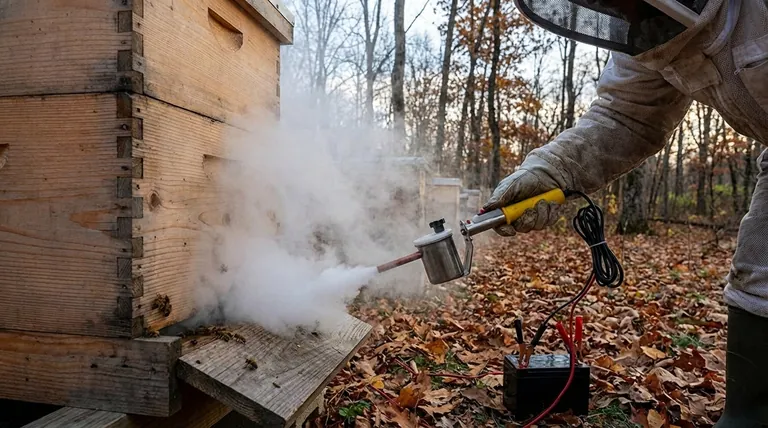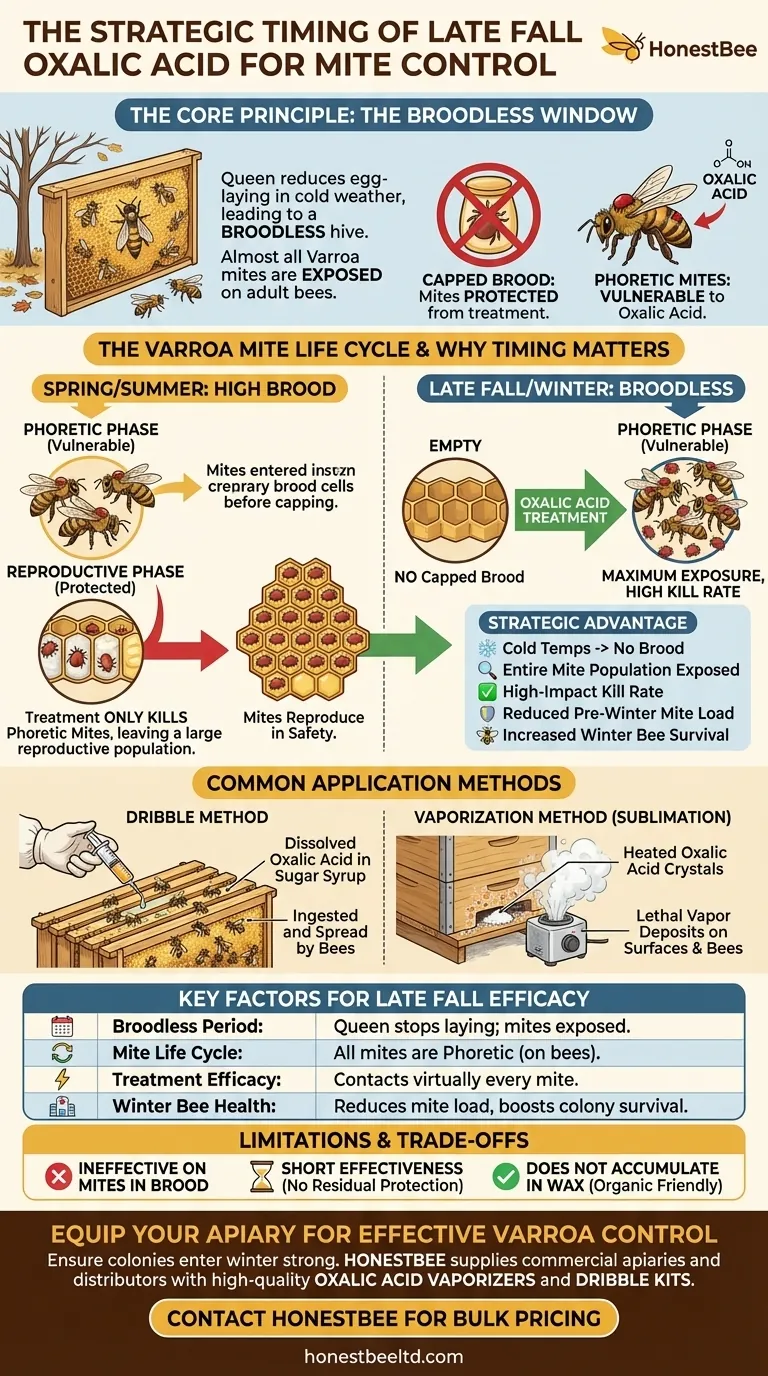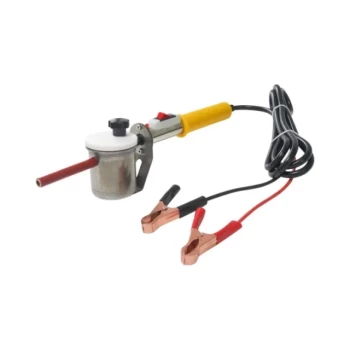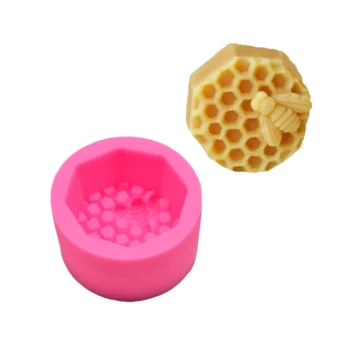In beekeeping, timing is everything. The use of oxalic acid for mite control in late fall is a strategic decision timed to coincide with a critical phase in the honey bee colony's annual cycle. It is applied during this window because the queen has typically stopped or significantly reduced her egg-laying, resulting in a "broodless" hive where nearly all parasitic Varroa mites are exposed and vulnerable.
The core principle is simple: Oxalic acid is highly effective against Varroa mites on the bodies of adult bees, but it cannot penetrate the capped cells where mites reproduce. By treating when there is no brood, you achieve the highest possible efficacy, drastically reducing the mite population just before the critical winter period.

The Key: Understanding the Varroa Mite Life Cycle
To grasp the importance of late fall treatment, you must first understand how the Varroa destructor mite lives and reproduces within a honey bee colony.
The Two Phases: Phoretic and Reproductive
The mite's life has two distinct stages. In the phoretic phase, mites are attached to the bodies of adult bees, feeding on their fat body tissue.
In the reproductive phase, a female mite enters a brood cell just before it is capped. She then lays eggs, which hatch and mate within the sealed cell, emerging with the young bee.
Why Capped Brood Protects Mites
Most mite treatments, including oxalic acid, cannot penetrate the wax cappings of brood cells. This means any mites reproducing inside those cells are completely protected from the treatment.
A treatment applied when a colony has a large amount of brood will only kill the phoretic mites, leaving the much larger reproductive population untouched and ready to emerge.
The Strategic Advantage of Late Fall Treatment
Aligning your treatment with the bees' natural cycle is the hallmark of an effective Integrated Pest Management (IPM) strategy. Late fall provides a unique window of opportunity.
Maximizing Mite Exposure
In late fall and early winter, cold temperatures cause the queen to cease laying eggs. This creates a natural broodless period that lasts for several weeks.
During this time, the entire mite population is forced into the phoretic state, riding on adult bees. With no mites hiding in capped brood, the population is completely exposed.
A High-Impact Kill Rate
Applying oxalic acid during this broodless window allows the treatment to contact virtually every mite in the hive. This results in a significantly higher kill rate than treatments performed at other times of the year.
Reducing the Pre-Winter Mite Load
Bees that will survive the winter are raised in the late summer and fall. A high mite load during this period weakens these "winter bees," shortening their lifespan and making the colony less likely to survive until spring.
A late-fall treatment dramatically lowers the mite population, relieving stress on the winter bees and giving the cluster a much better chance of survival.
Common Application Methods
The two approved methods for applying oxalic acid ensure it is distributed effectively among the bees.
The Dribble Method
Oxalic acid is dissolved in a warm sugar syrup solution. This solution is then dribbled directly onto the bees between the frames. The bees ingest and spread the syrup, distributing the acid throughout the cluster.
The Vaporization Method
Also known as sublimation, this method involves heating oxalic acid crystals with a specialized tool. The resulting vapor fills the hive, and as it cools, it deposits fine crystals on all surfaces, including the bees. These microscopic crystals are lethal to mites upon contact.
Understanding the Trade-offs and Limitations
While highly effective, oxalic acid is not a complete solution and must be used with a clear understanding of its limitations.
Ineffective on Mites in Brood
This cannot be overstated. Oxalic acid does not kill mites in capped brood. Using it when a significant amount of brood is present will yield poor results and provide a false sense of security.
It's a "Knockdown" Treatment, Not a Prophylactic
Oxalic acid has a very short period of effectiveness. It kills the mites present at the time of treatment but offers no residual protection against mites that emerge from brood cells later.
Does Not Accumulate in Wax
A major advantage of oxalic acid is that it is a natural component of honey and is not fat-soluble. This means, unlike some synthetic miticides, it does not build up in the beeswax comb, ensuring the purity of your honey and wax over time.
Making the Right Choice for Your Goal
Using this treatment effectively means matching it to the conditions in your hive and your broader management goals.
- If your primary focus is winter survival: Use oxalic acid once you have confirmed the colony is broodless (or as close to it as possible) to maximize the reduction of the winter mite population.
- If you are in a warmer climate without a distinct brood break: Oxalic acid can still be used, but it must be understood as only one part of a larger IPM plan, as a significant portion of the mite population will remain protected in the brood.
- If your goal is to maintain organic or treatment-free principles: Oxalic acid is an approved organic treatment and a powerful tool for managing mites without resorting to synthetic chemicals.
Properly timed, oxalic acid is one of the most effective and responsible tools a beekeeper has for ensuring the long-term health of their colonies.
Summary Table:
| Key Factor | Why It Matters for Late Fall Treatment |
|---|---|
| Broodless Period | Queen stops laying; no capped brood protects mites, exposing the entire population. |
| Mite Life Cycle | All mites are in the phoretic stage (on adult bees), making them vulnerable. |
| Treatment Efficacy | Achieves a high kill rate by contacting virtually every mite in the hive. |
| Winter Bee Health | Reduces mite load on critical winter bees, increasing colony survival chances. |
Equip Your Apiary for Effective Varroa Control
Ensure your colonies enter winter strong with the right tools. HONESTBEE supplies commercial apiaries and beekeeping equipment distributors with high-quality oxalic acid vaporizers and dribble kits through our wholesale-focused operations.
Contact HONESTBEE today to discuss bulk pricing on mite control equipment and secure your supplies for the upcoming season.
Visual Guide

Related Products
- 12V Bee Mite Removal Evaporator Oxalic Acid Vaporizer for Bee Fumigation Treatment 180W Atomization
- Durable 12V Oxalic Acid Vaporizer for Varroa Mite Treatment Beehive Beekeeping Tool
- Adjustable Formic and Acetic Acid Dispenser for Bee Mite Treatment
- Professional Bamboo Queen Isolation Cage
- Varroa Easy Check Mite Tester Kit Counter Alcohol Wash Jar
People Also Ask
- When is the best time to perform Oxalic Acid Vaporization? Maximize Mite Control for Healthy Hives
- What should be done after applying the vapor? A Step-by-Step Guide to Sealing Your Hive
- What are the registered application methods for oxalic acid in beekeeping? Choose the Right Varroa Mite Treatment
- What is the role of oxalic acid in plants? A Key to Plant Defense and Internal Regulation
- Why is oxalic acid not used in summer? Timing is critical for effective Varroa mite control.















